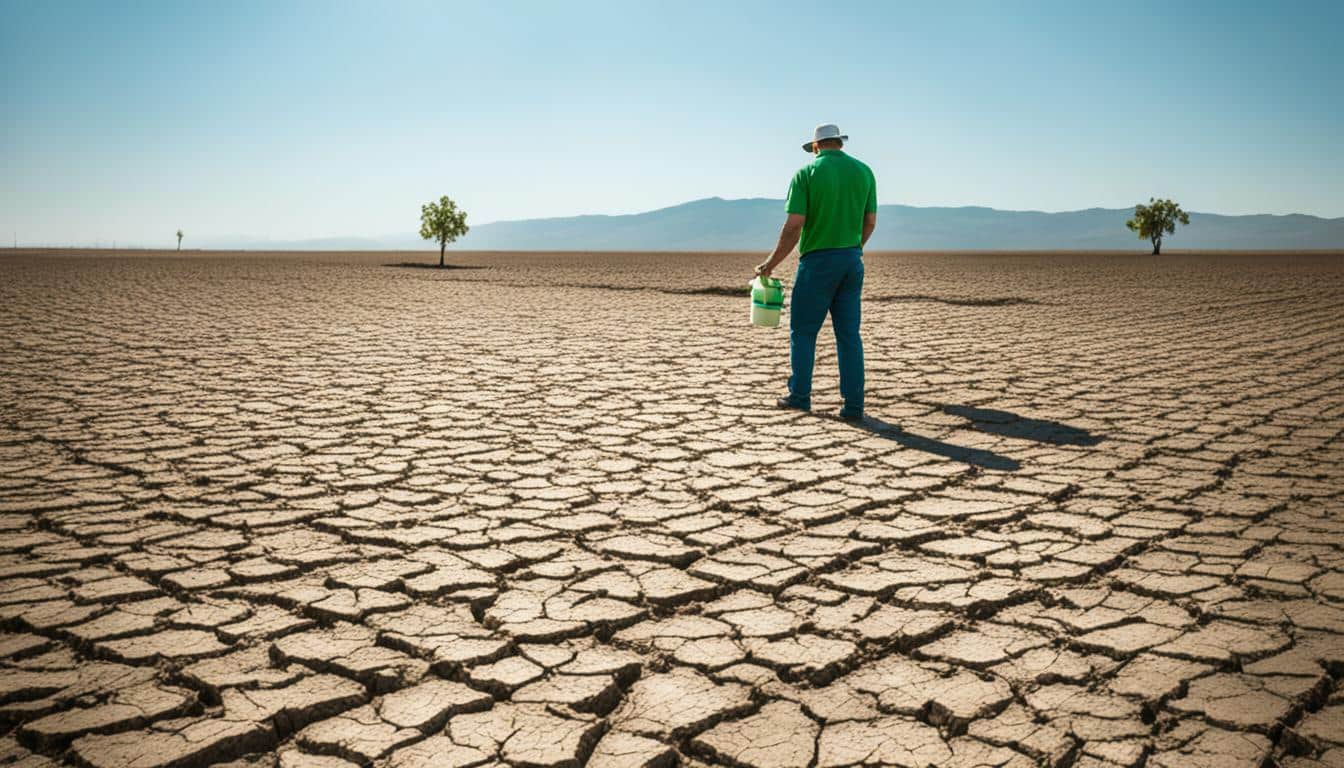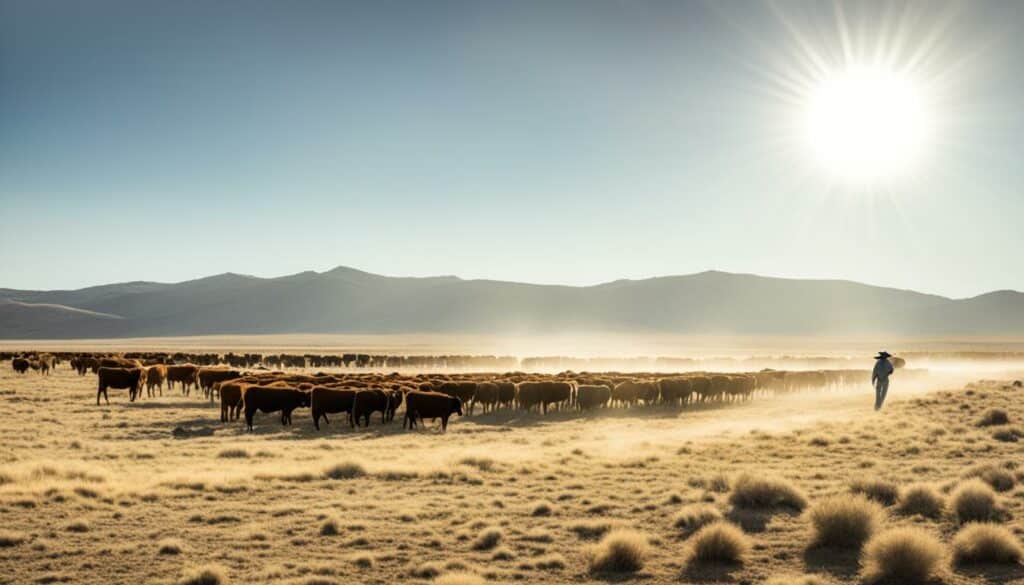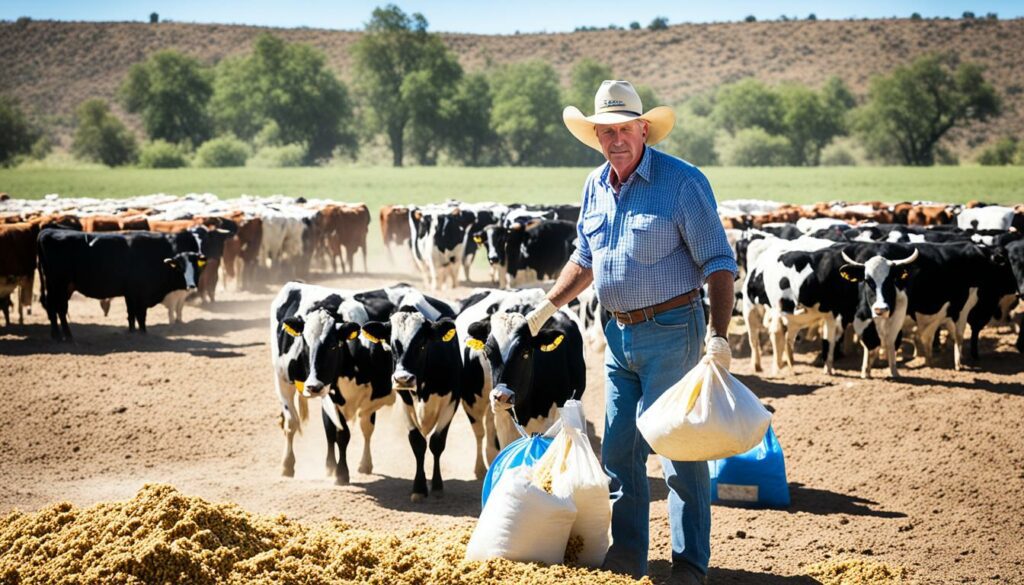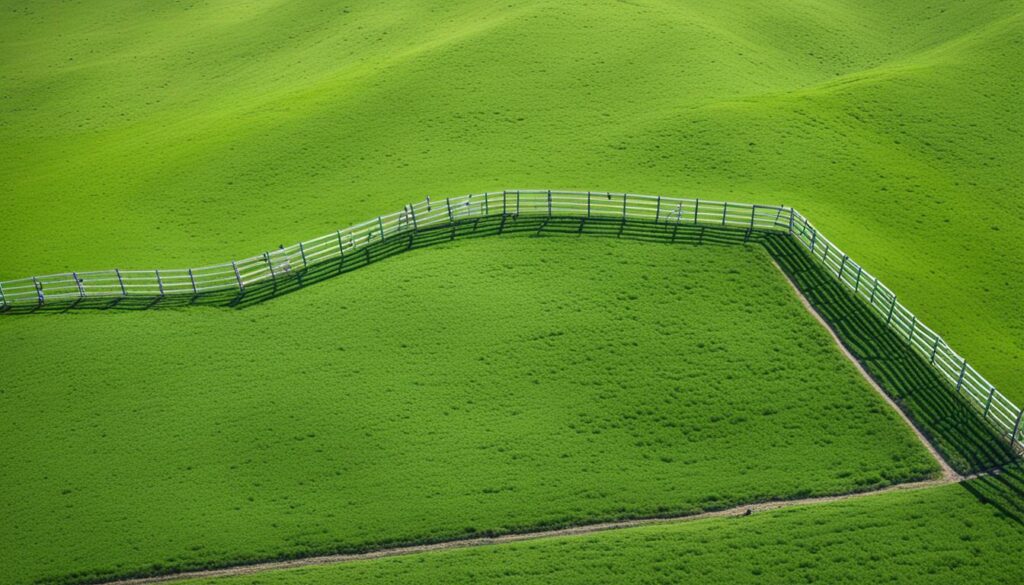Menu

Did you know that more animals in a space during a drought can make the area they eat in more even? This is good but it means they choose from fewer plant types than usual. I focus on helping people handle droughts and have explored ways to manage in these tough times.
To deal with summer droughts, farmers need to be smart with their land and water. They must use special ways to keep their gardens and farms growing well even when it doesn’t rain enough. By following the right methods, we make sure our farms and economy stay strong during dry spells.
Seeing how droughts affect farming is key to understanding their big challenges. They affect the economy, the environment, and people’s lives. We need smart plans to handle droughts well.
Droughts hurt farmers’ earnings when crops don’t grow. This has caused at least 2 billion dollars in losses for California each year since 2014. It also affects ranchers, making them spend more on their animals. This hits businesses hard, causing financial trouble. Power companies also see their costs rise because they need other fuels.
The environment takes a hard hit too. Droughts can harm fish and wildlife, affecting the whole ecosystem. Animals may suffer more diseases due to less food and water. Plus, low water levels disrupt businesses that use rivers.
On the social side, droughts cause real problems. They bring more public safety risks and health issues from the lack of water. People may fight over resources, making life stressful. Over 11 million people have died from drought since 1900. More than 2 billion have been affected.
To fight drought’s effects on farming, we must take action. The Dust Bowl in the 1930s caused deep scars in the U.S.’s farming. Severe droughts in Africa led to national emergencies. We need strong farming methods to survive these crises.
Making drought management work means coming up with smart plans. Saving water, caring for the soil, and using better ways to water crops are crucial. Knowing how past droughts affected us can help us plan better for the future.
We face a tough challenge in feeding the world’s growing population, especially in places prone to drought. Yet, with smart farming and planning, we can fight the bad effects. This way, we can keep making food for later generations too.
| Impact | Description |
|---|---|
| Economic | Loss of revenue for farmers, ranchers, and businesses reliant on farming. |
| Environmental | Losses in wildlife habitats, increased disease rates among wildlife, and hindered water transportation. |
| Social | Public safety risks, health issues, and resource conflicts leading to anxiety and lifestyle changes. |
Effective drought management starts with a detailed plan. This plan checks risks and the needs of livestock and crops. Droughts happen often, especially in places like Nebraska. So, it’s key to have drought plans as part of everyday farming. This helps keep the farm going smoothly even when drought strikes.
Managing livestock well is crucial during a drought. Beef producers must make tough choices, like whether to feed, ship, or sell cattle. They aim to keep the right number of animals. They check on how many cows they have, use their food smartly, and may feed cows in new ways. They might also wean beef calves early to cut down on how much food is needed and keep the cows healthy.

It’s also vital to have a solid plan for the land where animals graze. Set dates when specific actions kick in; these are Drought Planning Trigger Dates. These could use a tool like the Grass-Cast model. It helps farmers guess how much grass will grow in the drought. The aim is to lower how much food cows eat by feeding them other things while they’re out grazing. This, together with keeping an eye on the land, helps keep the area where animals eat in good shape.
It helps to use help from the government during a drought. Things like the USDA Drought Assistance and Farm Bill Disaster Assistance can be a lifeline. They offer important help to farmers and ranchers in tough times. Plus, knowing about the tax side of drought can help make smart money choices for the farm’s future.
A strong drought plan combines short and long-term tactics. By planning well and acting fast, farms can face droughts and still do well. Being ready and using varied strategies keeps the farm running, even when it’s very dry.
Managing drought well means using a range of drought indicators to act fast. We watch soil moisture, check on forage, and use weather data to get ahead of problems. Doing this lets us lessen drought’s harm on farms.
Keeping an eye on soil moisture levels helps us spot a drought early. If water levels start to drop, we know it’s time to act. For example, low soil moisture could mean less grass for cattle to eat by a certain date. This date is really important for both eastern Montana and western North Dakota, showing how crucial early warnings are.
Finding out how much food is available for animals is key. We need to keep track of forage from start to finish. Rain in late summer might help some grasses grow, affecting food supplies for animals. Knowing this lets us change how many animals are grazing, reducing harm to the environment and farm budget.
| Region | Perennial Grass Production Completed by July 1 | Additional Completion by August 1 |
|---|---|---|
| Eastern Montana | 91% | 91% |
| Western North Dakota | 75% | 85% |
Adding meteorological data into our early warning systems is crucial. Tools like the Palmer Drought Severity Index help us understand drought’s seriousness. Knowing how to use these tools means we can predict and soften the blow of droughts on farms. It gives us a chance to get ready before the toughest times hit.
It’s key to handle grazing pressure when drought hits. Techniques like rotating where animals graze, mixing animal groups, and planting tough plants help. They lessen the damage to fields and the strain on livestock.
Rotating where animals graze can really help. It gives plants time to grow back after being eaten. This method is vital for keeping grazing pressure in check.
Using tools like the Grazing Response Index makes managing grazing smarter. It shows when to move animals to let fields recover. So, even in droughts, you can keep things sustainable.

Mixing types of animals can make the most of food. Each group gets food that matches its needs best. This keeps field overuse low, helping the environment.
It also means you can keep a good number of animals without harm. Plus, it’s simpler and less stressful for everyone involved.
Planting tough plants is a smart move against drought. Grasses like crested wheatgrass and orchardgrass are great at surviving dry times. They use less water and stand up to heavy grazing.
Choosing the right plants helps fields and animals stand strong. This careful choice is a big part of good grazing management.
Using the best strategies keeps everything going, even when it’s tough. It’s about planning well and being ready to change. This way, we look after our land and animals for the long haul.
During drought, saving water is key for farming and helping animals. To do this, focus on simple actions like gathering rainwater and using it wisely. Also, think about ways to lessen water lost to air. These steps help make every drop count when water is scarce.
When it rains, save the water for later use. This is done through rainwater harvesting. It’s a great way to have extra water when there’s not enough. Setting up simple rain barrels or bigger collection systems can save a lot of water. Then, use this water to keep crops growing when the rain doesn’t fall.
Using water smartly in farming is crucial during drought. Methods like drip irrigation and soaker hoses stop water from being wasted. They water plants directly at their roots. Also, it’s smart to water plants early or late in the day. This keeps more water from disappearing into the air. All these ideas come together to use water better, helping farms stay productive.
To keep water from vanishing too quickly, cover the soil with mulch. This layer helps keep the moisture where it’s needed. It also means you might not have to water plants as often. Watering in the morning is another good trick. It stops a lot of water from evaporating too soon. Putting these steps into practice helps use water more sustainably in dry times.
When there’s not much forage, it’s vital to use a well-thought-out supplemental feeding strategy. This ensures your animals get enough nutrients. I’ll talk about picking the right foods, using smart feeding techniques, and finding alternative feed sources.

Choosing the right feed keeps animals healthy and productive. In dry times, give dry cows 0.5 to 0.75 pounds of extra protein daily. For cows that are nursing, offer 0.9 to 1.2 pounds. Mixing 50% trace mineralized salt with 50% dicalcium phosphate boosts phosphorus intake.
For protein and energy, use by-products like soyhulls, citrus pulp, and corn gluten feed.
Creep feeding is key for young animals in droughts. Weaning calves early, at 120 days or less, can boost their health. They’ll graze the same forage as cows.
Calves need high-quality food, about 4 to 5 pounds for every pound of growth. Using 75% grain and 25% cottonseed meal can add 0.5 to 1.0 pound daily.
Looking at other feed sources can help fill the gaps. Liquid supplements, molasses blocks, and protein blocks at 3 to 5 pounds per day can maintain animal health.
Range cubes, also 3 to 5 pounds daily, offer extra support. Feeding grains and molasses can make food choice better and increase energy. Self-fed supplements at 2.5 to 3.5 pounds per cow daily can also help. Include salt at 25% to 35% of the mix to limit intake.
By using the right foods, smart feeding methods, and alternative sources, you can keep your animals productive in tough times. A well-planned supplemental feeding strategy ensures they stay healthy and resilient.
In drought management, checking forage is key. It makes sure animals get enough nutrients. This means looking at what they eat, testing it, and checking for any harmful substances.
Doing feed testing and analysis keeps our animals safe and well-fed. We test for different nutrients to see if the forage is good for them. Looking at minerals helps us know if they need extra nutrients.
Once we have the test results, we can figure out if they need more food. This keeps them healthy even if the forage quality drops.
Drought can make plants toxic with nitrates. This can hurt or even kill animals. So, knowing if plants have too many nitrates is very important.
We check for nitrates in the plants to keep animals safe. Then we mix in safer plant types or change how much food they get. This prevents poisoning.
In drought times, we change what we feed animals. This includes using different foods like distillers’ grains or corn. Also, feeding alfalfa hay in small amounts each day helps a lot. It means we don’t use up all the good pastures too quickly.
This careful way of feeding, backed by regular testing, keeps animals well even in a drought. It helps them stay healthy and keep producing, no matter the feed challenges.
| Management Practice | Benefit |
|---|---|
| Culling late-calving, older, and less productive cows | Adjusts livestock inventory during drought conditions |
| Delay in turn-out to permanent pastures | Increases forage production by 10% or more |
| Early-weaning of calves | Provides high nutrient density, increasing grading probability |
| Rotational grazing systems | Optimises pasture use and supports sustainability |
| Planting oats early for grazing | Utilises spring moisture efficiently for forage production |
| Feeding alfalfa hay | Extends existing pasture by conserving forage resources |
In summer, high temperatures make it hard for gardens to grow. To help your garden, pick plants that need less water. They can survive drought better.
Look out for early signs of plants needing more water. Signs include wilted leaves or edges that look burned. Water them deeply once a week, not every day, to make their roots strong. This also stops salt from hurting the soil.

Putting mulch around your plants helps save water. It stops the soil from drying out too fast. Use natural mulch to make the soil better and reduce the need for water.
Plants like succulents don’t need much water. Plant them together to use water smarter. This makes your garden better at dealing with drought.
Use drip irrigation to water plants more efficiently. It can use up to 30% less water than other methods. This way, the water goes straight to the roots.
In dry areas, think about the soil and how to keep water in it. Don’t cut your plants too much unless it’s really hot. Using smart devices for watering, like ET sensors, saves a lot of water.
| State | Water Requirement | Recommended Practice |
|---|---|---|
| Utah | 1-2” (Spring/Fall), 2.5-3” (Summer) | Use deep watering techniques |
| Nevada | 20% less with ET sensors | Install efficient irrigation systems |
Use greywater and collect rain to help water your garden. Choose plants that fit the area’s moisture level. This way, your garden can stay healthy even when it’s dry.
By doing these tips for drought-tolerant plants, you help your garden and save water. It’s good for the environment too.
Gardening when there’s a drought is tough, but it isn’t impossible. With the right methods, your garden can still flourish. It’s all about picking the right plants and knowing how to treat the soil to keep them healthy.
Picking the right plants greatly helps in drought conditions. Choose xeric plants, which thrive on little water once they’ve settled. It’s also smart to look after weaker plants. These may need extra care, but they can still survive with the right attention.
Not all plants cope the same with dry spells, so choosing wisely is key. Selecting those that deal well with both drought and heat is essential.
In a drought, managing the soil well is crucial. Mulching can save a lot of moisture. Wood mulch is great for this. It keeps the soil cool and stops it from drying out too fast.
Water plants deeply every 10 days to help them cope. Collecting rainwater is another tip. It’s better for plants than tap water because it adds nutrients they need. Mixing these methods with not pruning too much and skipping fertiliser in droughts is smart.
So, picking the right plants, using mulch, and taking care of the soil are key steps. They help your garden stay healthy in dry times. With these strategies, your garden can survive and even thrive through drought periods.
Keeping a garden thriving when water is short is crucial. Sustainable gardening during drought needs smart choices. This includes using plants that grow naturally in the area. It also means using water wisely.
Choosing the right plants is key in a drought. Go for native ones. They don’t need as much water as other plants. This also means less work for you.
Native plants suited to the area usually have deep roots. These deep roots help them find water lower down in the soil. They make your garden strong without needing lots of water.

Watering the right way is essential in dry times. Use systems like drip irrigation. They can save half the water compared to normal sprinklers. Drip systems get water to the roots where it’s needed.
Water plants early in the morning before it gets hot. This helps them take in water better and stay healthy. Using a thick layer of mulch can also make a big difference. It keeps the soil damp, meaning you don’t have to water as much.
| Technique | Benefits |
|---|---|
| Drip Irrigation | Reduces water usage by up to 50% |
| Early Morning Watering | Ensures optimal absorption and healthier plants |
| Mulching | Keeps soil moist, reducing watering needs by 50% |
Mixing native plants with clever watering helps a garden survive drought. It saves water and keeps the garden going strong. This approach is good for your garden and for the planet.
It’s key to have good drought plans for looking after livestock. This ensures farms stay healthy and working well. Drought happens often, especially in places like Nebraska. So, having a clear plan to manage it helps keep animals healthy and farm output high.
Managing how much grass animals need with how much grows is smart. Putting up fences to divide fields and moving animals often to new parts of the field help a lot. This way, the grass doesn’t get eaten up too quickly. Also, by waiting a bit before letting animals out to the fields, the grass has more time to grow. This simple action can boost the amount of grass by over 10% when the soil is too dry.
Knowing how bad a drought is, from D0 (a bit dry) to D4 (really dry), is important. It helps to decide how many animals a farm can feed. It’s also useful in picking the right time to start and stop the grazing season. When it’s too dry, it might be best to take the calves off milk early. This helps them eat solid food better. For every 2.5 days they’re weaned, a cow gets an extra day of good grazing.
Adding extra food for the animals can really help, too. Treating crop bits with ammonia and using corn that’s been through a tough time to feed cattle can do wonders. But, it’s also crucial to know which plants could be harmful if they’re eaten and to have safe food choices ready. This makes sure the animals get all they need to stay healthy.
The government can step in to help during droughts. They offer money help and plans that cover farms in bad times. They also help with knowing which animals to sell when the farm can’t feed them all. This keeps the farm running well.
A good plan to help the land use water better can be a lifesaver. Putting up more fences in bigger fields to move animals around is clever. It means all the grass gets eaten before it dries up. Being ready for a drought by June 1st if less than half the usual rain has fallen sets farms up for success in the long run.
Using rotational grazing benefits both the livestock and the land. It means moving animals from one pasture to another. This lets each area rest, which is great for its health and growth. This method helps the environment and makes farming smoother.

Rotational grazing cuts down on the need for pesticides. Healthy pastures fight off weeds on their own. It also helps lower the amount of greenhouse gases released. This happens because there’s no need to store manure. Better feed quality and more carbon in the soil are extra good points. Rotational grazing also makes pastures better at standing up to drought.
However, it’s important to move the animals around regularly. This stops the ground from getting too compact and keeps the water clean.
To make rotational grazing work, long rests for pastures are key. Waiting long enough between grazing times keeps the pastures healthy. Rest-rotation grazing is a good method. It means letting pastures rest for at least a year. This makes them better for birds and other wildlife. Light to moderate numbers of animals help the land recover.
For some farms, moving animals seasonally is a better fit. This is called deferred-rotation grazing. For example, some pastures are used in the spring, and others not until autumn. This system, if done well, helps the pastures last longer.
Watching and changing these methods are crucial in a dry spell. It ensures both the animals and the land stay healthy.
With the forecast of low forage production in 2021, we must find ways to keep our livestock well-fed. The northern Plains are facing an extended dry spell, making it crucial to plan ahead. Using annual forages can be a lifeline during dry times.
Annual forages like forage barley, oats, wheat, and Siberian foxtail millet do well in dry areas. A study in Wishek, N.D. found that barley and oats grow better than triticale when it’s dry. For those who can’t grind feed, barley is a good choice.
Siberian foxtail millet is great for hot weather, as it’s good at finding moisture and nutrients. Planting at the right time, like just before a spring rain, is key for a good start. High soil moisture after planting is also vital. Late in the season, you can grow winter cereals for extra forage the next year.
It’s vital to manage your forage well during a drought to keep the water use efficient. Don’t let animals overgraze to save the land’s moisture. Experts can give advice on how to seed correctly. Following their advice can make a big difference in dealing with drought, helping your farm stay productive and sustainable.
Planning for summer drought is about using farming methods wisely. It’s also about saving water and using smart ways to keep things growing when rain is scarce.
Drought really hits agriculture hard. It slows down plant growth and cuts crop results. It also makes it tough to feed livestock and harms the soil.
Good drought plans check for risks and look at what livestock and crops need. They include ideas like different ways to feed animals and to save water.
To spot drought early, watch the moisture in the soil and how much grass is available. Also, keep an eye on the weather to act fast.
To handle grazing, rotate where animals graze. Mix different animals to use grass better. Also, plant tough grass that can survive grazing.
Saving water in a drought means collecting rain and wisely watering crops. It also involves stopping water from evaporating too quickly.
Extra feeding for livestock means choosing the right food and smart feeding methods. It’s also about finding other sources for their food.
To check the food quality, keep testing it. Look out for high nitrates. Adjust the food you give animals to keep them healthy.
Making the land need less water starts with choosing plants that can survive a drought. This cuts the work needed to keep the area nice.
In a drought, gardeners should pick plants that don’t mind dry spells. They can also cover the soil with mulch to keep in moisture.
Sustainable gardening in a drought means planting local plants and watering in ways that don’t waste water. This helps the garden stay strong in changing weather.
Livestock plans for drought should make sure they have enough to eat and drink. They should also aim to keep the animals healthy on less food.
Moving animals around to graze helps the land stay healthy and grow better food. Letting parts of the farm rest helps it recover and avoid damage, a key point in drought.
Planting new forages stops the farm from running out of food during droughts. It’s a way to make sure there’s always something to eat for the animals.